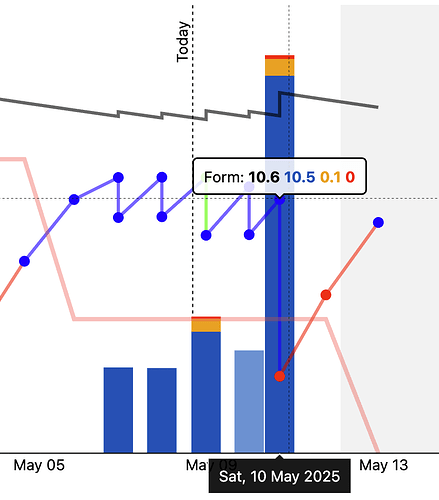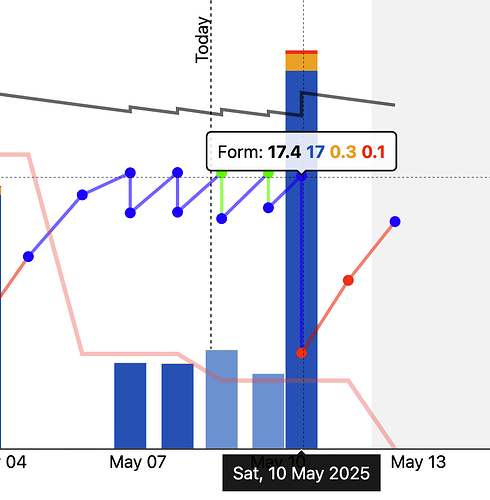I have my A race of the season on Saturday. It’s a gravel race which I anticipate will take about 4.5 to 5.5 hours to complete, with a couple sustained long climbs mixed in with rolling terrain. I have been using Forecast AI to train for the race since the beginning of February as a “Mountainous Gravel Race”. Forecast AI has had me training about 10-15 hours a week. Forecast AI has my training volume for Monday-Friday this week at 8 hours (with some intensity), which seems like more volume than consensus for a taper week. Has anyone else had experience with Forecast AIs taper, and found that it worked for them?
I do not have that experience with it, yet. However, plenty of taper experience and that does not seem out of the norm. Each person is different but dropping volume 10-20% is advised.
One way to gauge how much down time you need in the taper week is to see how well you do on rides of similar duration and focus/intensity in green/blue/yellow status. I find that when the event is similar to rides I do somewhat frequently, I don’t need much of a taper and can train and keep sharp up until race day. I just don’t overdo things 1-2 days before the race. XFAI does the same sort of analysis and ensures you’re fresh enough on race day for the event readiness you are wanting while not compromising on your fitness by detraining unnecessarily. It goes back a week for the taper but you could see more training than expected if you’re highly trained relative to the event’s xss requirements.
I don’t think this exactly follows my scenario. Judging by the predicted XSS, the race is going to be about 50% more than my biggest XSS training rides. XFAI also only has me going into the event as fresh, and not very fresh. One additional observation I’ve had is that if I account for the anticipated XSS of the event, XFAI has me at a positive ramp rate for this week, which leads me to believe that it’s not actually trying to optimize me for the event, but instead optimizing for sustained improvement. Also because my ramp rate has been an average of 2.7 for 10 weeks now, it feels like I need a more aggressive taper to be optimal for the event, but I obviously can’t say that for sure.
If you like to share some details, we can dig into things more and examine how XFAI is reading things. It doesn’t have a lot of opacity in the end so we can usually deduce things from what is saying.
It does things in some logical way, even if it’s not always obvious at first and may appear contrary to what is expected. It’s got me sometimes, where I think there’s a bug or something only to spend hours realiziing it had it right all along. That being said, it’s not error-free so maybe there is something to look into further.
My sense is that even at 50% higher, you don’t need to be very fresh for the event to achieve your Event Readiness and so it doesn’t see a need to back off the training, especially if your target is still something that requires more training.
That makes complete sense. Feel free to take a look through my account and share any insights if you have time. I’d appreciate it.
Objectively, I can see how the plan XFAI recommended might have worked if I weren’t carrying so much accumulated fatigue. In hindsight, I probably should have adjusted my recovery needs a few weeks ago when that fatigue started to build. I kept pushing, assuming XFAI would back me off significantly during the taper, but that assumption seems to have been incorrect.
That said, I think the core issue is that continuing to train right up to the event might technically be the optimal strategy, but it sits right next to a cluster of bad outcomes if I arrive at the event too fatigued. A more aggressive taper might leave me slightly less prepared in theory, but it’s a more stable solution with much lower downside risk. I am not an expert in training, but this statement feels correct based on the exposure I’ve had.
… and hence we have Event Readiness ![]()
If you lower it, you’ll need to be fresher and more trained leading into the event.
I’m not entirely sure what I should have done differently with Event Readiness. I used the “Auto-calculate Readiness” feature, which set the value to 1.9. I imagine that if I had entered with a higher level of fitness, I could have selected a readiness value of 1.0, and the plan would have brought me into the event feeling fresher.
Since I didn’t have the fitness to support that level of freshness, the algorithm seems to be balancing recovery with the potential for continued gains, leaning more toward additional training. That feels like a riskier approach to me. The extra training might pay off with a fitness bump that still allows for good performance, but it also increases the chance of arriving at the event under-recovered and having a rough day.
If the plan leaned more toward freshness, I might sacrifice some peak potential, but I think the average outcome would be more reliable and I’d feel more confident lining up on race day. I really wish there were a way to preview or explore that more conservative, freshness-focused approach. I’ve had good results with XFAI and want to feel like I’ve followed it through to the event without feeling like I’m rolling the dice on race-day performance.
1.9 seems pretty good to me so really not much you could do here. It may have given you higher targets to reach and thus less flexibility in your plan, is the main drawback to better ER values.
We’re looking at this actually and there might be some variation between how the main Forecast AI algorithm computes the taper compared to the Adapt Forecast function. You can see this for yourself if you Run Foreast AI by clicking Change Program. Forecast AI provides a bit more freshness leading into the event.
Try the Forecast AI option and see if that aligns things a bit better. It seems to me like it does and we can make an adjustment.
Thanks for your patience and help.

